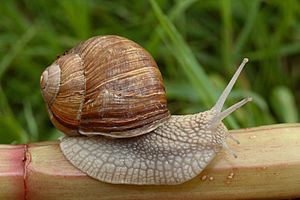Helicidae facts for kids
Quick facts for kids Helicidae |
|
|---|---|
 |
|
| Helix pomatia | |
| Scientific classification |
|
| Kingdom: | Animalia |
| Phylum: | Mollusca |
| Class: | Gastropoda |
| Subclass: | Heterobranchia |
| Clade: | Euthyneura |
| Order: | Panpulmonata |
| Clade: | Eupulmonata |
| Clade: | Stylommatophora |
| Superfamily: | Helicoidea |
| Family: | Helicidae Rafinesque, 1815 |
| Type genus | |
| Helix Linnaeus, 1758 |
|
| Subfamilies | |
|
|
The Helicidae are a big family of land snails. They breathe air and are often called "typical snails." You can find them in many different sizes, from small to large.
Some snails from this family are even eaten as food! Two famous ones are the garden snail (Cornu aspersum) and the "escargot" (Helix pomatia). Scientists have learned a lot about how these two snails live.
Contents
Shells of Helicidae Snails
Helicidae snails usually have shells that are round or globe-shaped. Some types, like the Cepaea snails, have shells with bright colors and cool patterns.
Anatomy of Helicidae Snails
These snails can pull their whole body inside their shell when they need to hide or feel safe. Their tail does not have a special gland that makes mucus.
Inside their mouth, they have a jaw. This jaw can have ridges or folds. They also have a special tongue-like ribbon called a radula. The radula has many rows of tiny teeth. These teeth help the snail scrape and chew its food.
A special part of these snails' bodies is called a diverticulum. Some snails in this family use "love darts" when they mate. These darts are small, sharp structures used during their mating process. Each snail has one dart setup, which includes two small tubes.
The number of chromosomes in these snails can range from 21 to 30.
Where Helicidae Snails Live
This family of snails originally comes from Eurasia. This area includes Europe and Asia.
However, some species, like the garden snail (Cornu aspersum), have traveled and now live in many other parts of the world. This often happens by accident. Snail eggs are laid in the soil. So, they can easily travel hidden in soil when plants are moved from one place to another.
Types of Helicidae Snails
The Helicidae family is divided into three main groups called subfamilies. Scientists use special tests to figure out these groups.
Subfamily Helicinae
In this group, the snails' glands are divided. Their love darts usually have four blades. They also have two special parts called penial papillae.
Tribe Allognathini
- Cepaea
- Iberus
Tribe Helicinini
- Helix - This is the main type of snail for the whole family.
- Levantina
Tribe Otalini
- Cantareus
- Cornu
- Eobania
- Otala
Tribe Thebini
- Theba
Subfamily Murellinae
Tribe Murellini
- Macularia
- Marmorana
Subfamily Ariantinae
In this group, the snails' glands can be divided or not. Their love darts have two to four blades. They only have one penial papilla.
- Arianta
- Campylaea
- Chilostoma
- Helicigona
Images for kids
-
Helicid snails for sale as food in Italy. From the front: Eobania vermiculata, Cantareus apertus, and Helix sp.
-
Iberus gualtieranus alonensis
See also
 In Spanish: Helícidos para niños
In Spanish: Helícidos para niños





